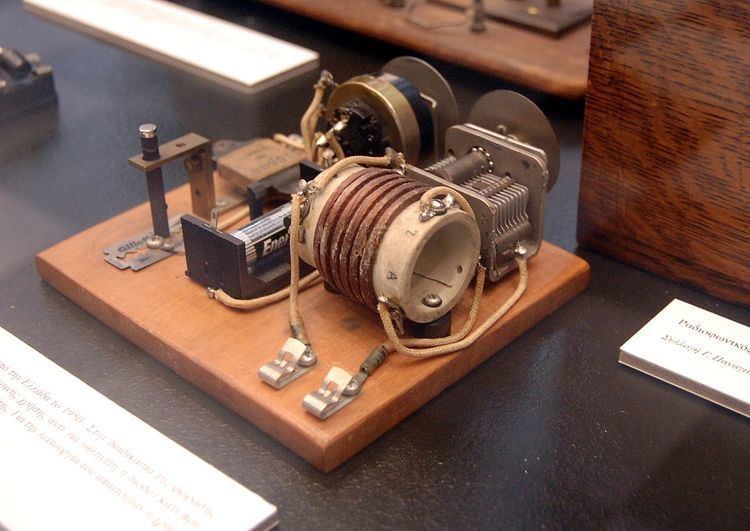 | ||
Similar All American Five, Batteryless radio, Transistor radio | ||
A foxhole radio is a makeshift radio that was first used by soldiers in World War II, specifically at Anzio, spreading later across the European and Pacific theaters. There were different versions of the foxhole radio; all used a safety razor blade as a radio wave detector. The "classic" foxhole radio was configured like a crystal radio, with the blade acting as the crystal and a wire, safety pin, or, later, a pencil serving as the cat's whisker. Other versions were similar to the microphone detector of David Edward Hughes, rediscovered by Harry Shoemaker and Walter Wentworth Massie, popular among amateurs in the early days of radio. They were named, likely by the press, for the foxhole, a defensive fighting position developed before and during the war.
Contents
The foxhole radio is like a crystal set, in that it does not require an external power source. The radio is powered by the radio signal it receives. This makes the foxhole radio ideal for prisoners of war (POW); though it is unclear if this type of receiver was used by prisoners of war during World War II (prison camp sets were usually more sophisticated), there are accounts of sets built by American POWs during the Vietnam War.
History
The maker of the first foxhole radio is unknown, but it was almost certainly invented by a soldier stationed at the Anzio beachhead during the stalemate of February – May 1944. One of the first newspaper articles about a foxhole radio ran in the New York Times April 29, 1944. That radio was built by Private Eldon Phelps of Enid, Oklahoma, who later claimed to have invented the design. It was fairly crude, a razor blade stuck into a piece of wood acted as the crystal, and the end of the antenna wire served as a cat whisker. He managed to pick up broadcasts from Rome and Naples.
The idea spread across the beachhead and beyond. Toivo Kujanpaa built a receiver at Anzio and was able to receive German propaganda programs. The propaganda programs were directed towards Allied military from an Axis station in Rome. Many veterans of Anzio refer to the female announcer they heard as "Axis Sally", the nickname usually used when referring to propagandist Mildred Gillars, however Gillars broadcast from Berlin, and the men at Anzio were more likely hearing Rita Zucca, who broadcast from Rome. Though Gillars is more often associated with the "Sally" moniker, it was Zucca who actually referred to herself as "Sally" during broadcasts.
There were also allied broadcasts available, from the 5th Army Mobile Radio Station and the BBC.
American G.I.s in Italy would put several radios together. The G.I.s would listen at night near the front lines to phonograph records played on a radio station in Rome. You could usually hear a radio station on a foxhole radio if you lived twenty five or thirty miles away. In 1942, Lieutenant Colonel R. G. Wells—a prisoner of war in Japan—built a foxhole radio to get news about the international situation. "The whole POW camp craved news", according to Wells.
Designs
Foxhole radios were built using numerous designs. Most used a double edge razor blade with a wire running from each edge between the headphone terminals and antenna, and a pencil lead sitting on the blade. Most of these wartime sets did not have a slider-tuner arm. Without a tuner, they could only tune to one frequency. Richard Lucas, a POW in Vietnam, constructed a radio in camp and built his own earphones. Richard built his earphones by binding four nails together with cloth then winding wire and dripping wax over the turns. After about ten layers of wire he placed it in a piece of bamboo. A tin can lid was placed over the coil of wire. The listener connected the improvised earphone to the foxhole radio and received three radio stations. The best listening was at night, according to Lucas.
Operation
These radio receivers are only crudely tuned to a frequency by the aerial and coil. The radio frequency signal, received by the aerial, causes an electric current to oscillate back and forth in the coil. To receive an AM (amplitude modulation) radio transmission the signal must be rectified to recover the audio modulation of the signal. The safety razor and graphite point of the pencil form a crude single-diode rectifier, the oxide layer on the razor blade and the point contact of the pencil lead only allowing the current to flow in one direction. After rectification by this improvised diode, the audio signal drives the headphones.
